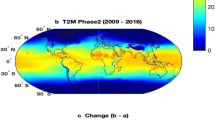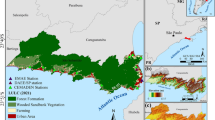Abstract
This study quantifies heat-stress hazard (air temperature), vulnerability (heat vulnerability index and age score), and risk (heat-related mortality) on the district scale in Seoul, Korea, for a comprehensive heat-stress impact assessment. Moreover, the heat-stress impact assessment is evaluated by checking the spatial consistency between heat-stress hazard, vulnerability, and risk, which was rarely done before. We applied numerical and geo-empirical models to simulate the spatial pattern of heat-stress hazard. For heat-stress vulnerability, we used demographic and socioeconomic factors. Heat-related mortality was estimated based on an event-based heat-stress risk analysis. Results are that heat-stress hazard, vulnerability, and risk are spatially variable in Seoul. The highest heat-stress hazard was detected in the districts Mapo, Yeongdeungpo, and Yangcheon, the highest vulnerability in Jongno and the highest risk in Jongno and Yangcheon. The different components (heat-stress hazard, vulnerability, and risk) and variables (heat vulnerability index and percentage of seniors) showed different spatial patterns. Knowledge about the causes of higher heat-stress risk, either the hazard or vulnerability, is helpful to design tailored adaptation measures that focus on the reduction of thermal loads or on the preparation of the vulnerable population. The evaluation showed that heat-stress vulnerability and hazard explain the spatial pattern of risk only partly. This highlights the need to evaluate heat-stress impact assessment systems to produce reliable urban heat-stress maps.



Similar content being viewed by others
References
AMS (American Meteorological Society) (2010) Glossary of meteorology. Online http://glossary.ametsoc.org/, Accessed 2017-07-13
Bao J, Li X, Yu C (2015) The construction and validation of the heat vulnerability index, a review. Int J Environ Res Public Health 12:7220–7234. https://doi.org/10.3390/ijerph120707220
Benmarhnia T, Kihal-Talantikite W, Ragettli MS, Deguen S (2017) Small-area spatiotemporal analysis of heatwave impacts on elderly mortality in Paris: a cluster analysis approach. Sci Total Environ 592:288–294
Bernhard MC, Kent ST, Sloan M, Evans MB, McClure LA, Gohlke JM (2015) Measuring personal heat exposure in an urban and rural environment. Environ Res 137:410–418. https://doi.org/10.1016/j.envres.2014.11.002
Borden KA, Cutter SL (2008) Spatial patterns of natural hazards mortality in the United States. Int J Health Geogr 7:64–64. https://doi.org/10.1186/1476-072X-7-64
Boumans RJM, Phillips DL, Victery W, Fontaine TD (2014) Developing a model for effects of climate change on human health and health–environment interactions: heat stress in Austin, Texas. Urban Climate 8:78–99
Buchin O, Jänicke B, Meier F, Scherer D, Ziegler F (2016) The role of building models in the evaluation of heat-related risks. Nat Hazards Earth Syst Sci 16:963–976. https://doi.org/10.5194/nhess-16-963-2016
Buscail C, Upegui E, Viel J-F (2012) Mapping heatwave health risk at the community level for public health action. Int J Health Geogr 11:1–9. https://doi.org/10.1186/1476-072X-11-38
Chen K, Huang L, Zhou L, Ma Z, Bi J, Li T (2015) Spatial analysis of the effect of the 2010 heat wave on stroke mortality in Nanjing, China. Sci Report 5:1–11. https://doi.org/10.1038/srep10816
Chow WTL, Chuang W-C, Gober P (2012) Vulnerability to extreme heat in metropolitan Phoenix: spatial, temporal, and demographic dimensions. Prof Geogr 64:286–302
Dong W, Liu Z, Zhang L, Tang Q, Liao H, Li X (2014) Assessing heat health risk for sustainability in Beijing’s urban heat island. sustainability 6:7334–7357. https://doi.org/10.3390/su6107334
Gabriel KMA, Endlicher WR (2011) Urban and rural mortality rates during heat waves in Berlin and Brandenburg, Germany. Environ Pollut 159:2044–2050. https://doi.org/10.1016/j.envpol.2011.01.016
Gallup Korea (2016) Eight out of 10 households have air conditioners in S. Korea Yonhap News 29. July 2016. http://english.yonhapnews.co.kr/news/2016/07/29/0200000000AEN20160729005400315.html
Gasparrini A, Guo Y, Hashizume M, Lavigne E, Tobias A, Zanobetti A, Schwartz JD, Leone M, Michelozzi P, Kan H, Tong S, Honda Y, Armstrong BG (2016) Changes in susceptibility to heat during the summer: a multicountry analysis. Am J Epidemiol 183:1027–1036. https://doi.org/10.1093/aje/kwv260
Gosling SN, Bryce EK, Dixon PG, Gabriel KMA, Gosling EY, Hanes JM, Hondula DM, Liang L, Mac Lean PAB, Muthers S, Nascimento ST, Petralli M, Vanos JK, Wanka ER (2014) A glossary for biometeorology. Int J Biometeorol 58:277–308. https://doi.org/10.1007/s00484-013-0729-9
Ha J, Kim H (2013) Changes in the association between summer temperature and mortality in Seoul, South Korea. Int J Biometeorol 57:535–544. https://doi.org/10.1007/s00484-012-0580-4
Ha J, Shin YS, Kim H (2011) Distributed lag effects in the relationship between temperature and mortality in three major cities in South Korea. Sci Total Environ 409:3274–3280. https://doi.org/10.1016/j.scitotenv.2011.05.034
Hajat S, O’Connor M, Kosatky T (2010) Health effects of hot weather: from awareness of risk factors to effective health protection. Lancet 375:856–863. https://doi.org/10.1016/S0140-6736(09)61711-6
Harlan SL, Brazel AJ, Prashad L, Stefanov WL, Larsen L (2006) Neighborhood microclimates and vulnerability to heat stress. Soc Sci Med 63(11):2847–2863. https://doi.org/10.1016/j.socscimed.2006.07.030
Harlan SL, Declet-Barreto JH, Stefanov WL, Petitti DB (2013) Neighborhood effects on heat deaths: social and environmental predictors of vulnerability in Maricopa County, Arizona. Environ Health Perspect 121:197–204. https://doi.org/10.1289/ehp.1104625
Hondula DM, Barnett A (2014) Heat-related morbidity in Brisbane, Australia: spatial variation and area-level predictors. Environ Health Perspect 122(8):831–836. https://doi.org/10.1289/ehp.1307496
Hondula DM, Davis RE, Leisten MJ, Saha MV, Veazey LM, Wegner CR (2012) Fine-scale spatial variability of heat-related mortality in Philadelphia County, USA, from 1983-2008: a case-series analysis. Environ Health 11:2–11
Hu K, Yang X, Zhong J, Fei F, Qi J (2017) Spatially explicit mapping of heat health risk utilizing environmental and socioeconomic data. Environ Sci Technol 51:1498–1507. https://doi.org/10.1021/acs.est.6b04355
Inoguchi T, Basanez M, Tanaka A, Dadabaev T (2005) Values and life styles in urban Asia. A cross-cultural analysis and sourcebook based on the AsiaBarometer Survey 2003. The University of Tokyo
IPCC (2012) Managing the risks of extreme events and disasters to advance climate change adaptation. Special Report of the Intergovernmental Panel on Climate Change
Johnson DP, Stanforth A, Lulla V, Luber G (2012) Developing an applied extreme heat vulnerability index utilizing socioeconomic and environmental data. Appl Geogr 35:23–31. https://doi.org/10.1016/j.apgeog.2012.04.006
Joshi SS, Lesser TJ, Olsen JW, O’Hara BF (2016) The importance of temperature and thermoregulation for optimal human sleep. Energ Buildings 131:153–157. https://doi.org/10.1016/j.enbuild.2016.09.020
Kim Y-H, Baik J-J (2002) Maximum urban heat island intensity in Seoul. J Appl Meteorol 41:651–659
Kim Y-H, Baik J-J (2005) Spatial and temporal structure of the urban heat island in Seoul. J Appl Meteorol 44:591–605
Kim Y, Joh S (2006) A vulnerability study of the low-income elderly in the context of high temperature and mortality in Seoul, Korea. Sci Total Environ 371:82–88. https://doi.org/10.1016/j.scitotenv.2006.08.014
Kim E-J, Kim H (2017) Effect modification of individual- and regional-scale characteristics on heat wave-related mortality rates between 2009 and 2012 in Seoul, South Korea. Sci Total Environ 595:141–148. https://doi.org/10.1016/j.scitotenv.2017.03.248
Kim S, Ryu Y (2015) Describing the spatial patterns of heat vulnerability from urban design perspectives. Int J Sust Dev World 22:189–200
Kim H, Ha J, Park J (2006) High temperature, heat index, and mortality in 6 major cities in South Korea. Arch Environ Occup Health 61:265–270
Kim KR, Yi C, Lee J-S, Meier F, Jänicke B, Fehrenbach U, Scherer D (2014) BioCAS: Biometeorological Climate impact Assessment System for building-scale impact assessment of heat-stress related mortality. Die Erde 145:62–79. https://doi.org/10.12854/erde-145-6
Kim S-H, Jo S-N, Myung H-N, Jang J-Y (2014b) The effect of pre-existing medical conditions on heat stroke during hot weather in South Korea. Environ Res 133:246–252. https://doi.org/10.1016/j.envres.2014.06.003
Kim CT, Lim Y-H, Woodward A, Kim H (2015) Heat-attributable deaths between 1992 and 2009 in Seoul, South Korea. PLoS One 10(2):1–14. https://doi.org/10.1371/journal.pone.0118577
Kim H, Kim Y-K, Song S-K, Lee HW (2016) Impact of future urban growth on regional climate changes in the Seoul Metropolitan Area, Korea. Sci Total Environ 571:355–363. https://doi.org/10.1016/j.scitotenv.2016.05.046
Korean Statistical Information Service (2014) Online http://kosis.kr accessed at 2017-01-14
Kuras ER, Richardson MB, Calkins MM, Ebi KL, Hess JJ, Kintziger KW, Jagger MA, Middel A, Scott AA, Spector JT, Uejio CK, Vanos JK, Zaitchik BF, Gohlke JM, Hondula DM (2017) Opportunities and challenges for personal heat exposure research. Environ Health Perspect 125(8):1–9. https://doi.org/10.1289/EHP556
Milojevic A, Armstrong BG, Gasparrini A, Bohnenstengel SI, Barratt B, Wilkinson P (2016) Methods to estimate acclimatization to urban heat island effects on heat- and cold-related mortality. Environ Health Perspect 124(7):1016–1022. https://doi.org/10.1289/ehp.1510109
Nguyen JL, Dockery DW (2016) Daily indoor-to-outdoor temperature and humidity relationships: a sample across seasons and diverse climatic regions. Int J Biometeorol 60:221–229. https://doi.org/10.1007/s00484-015-1019-5
Park H-S (1986) Features of the heat island in Seoul and its surrounding cities. Atmos Environ 20:1859–1866
Perego S (1999) Metphomod - a numerical mesoscale model for simulation of regional Photosmog in complex terrain: model description and application during Pollumet 1993 (Switzerland). Meteorog Atmos Phys 70:43–69
Quinn A, Shaman J (2017) Health symptoms in relation to temperature, humidity, and self-reported perceptions of climate in New York City residential environments. Int J Biometeorol 61:1209–1220. https://doi.org/10.1007/s00484-016-1299-4
Reid CE, O’Neill MS, Gronlund CJ, Brines SJ, Brown DG, Diez-Roux AV, Schwartz J (2009) Mapping community determinants of heat vulnerability. Environ Health Perspect 117(11):1730–1736. https://doi.org/10.1289/ehp.0900683
Ren C, Ng E Y, Katzschner L (2011) Urban climatic map studies: a review. Int J Climatol 31:2213–2233. https://doi.org/10.1002/joc.2237
Romero-Lankao P, Qin H, Dickinson K (2012) Urban vulnerability to temperature-related hazards: a meta-analysis and meta-knowledge approach. Glob Environ Chang 22:670–683. https://doi.org/10.1016/j.gloenvcha.2012.04.002
Rosenthal JK, Kinney PL, Metzger KB (2014) Intra-urban vulnerability to heat-related mortality in New York City, 1997–2006. Health Place 30:45–60. https://doi.org/10.1016/j.healthplace.2014.07.014
Scherer D, Fehrenbach U, Lakes T, Lauf S, Meier F, Schuster C (2013) Quantification of heat-stress related mortality hazard, vulnerability and risk in Berlin, Germany. Erde 3–4:238–259. https://doi.org/10.12854/erde-144-17
Schuster C, Honold J, Lauf S, Lakes T (2017) Urban heat stress: novel survey suggests health and fitness as future avenue for research and adaptation strategies. Environ Res Lett 12:1–10. https://doi.org/10.1088/1748-9326/aa5f35
Seoul Metropolitan Government (2017) Seoul statistics by category. Online http://english.seoul.go.kr/get-to-know-us/statistics-of-seoul/seoul-statistics-by-category/ Accessed 2017-06-26
Son J-Y, Lee J-T, Anderson GB, Bell ML (2011) Vulnerability to temperature-related mortality in Seoul, Korea. Environ Res Lett 6:034027. https://doi.org/10.1088/1748-9326/6/3/034027
Son J-Y, Lee J-T, Bell ML (2012) The impact of heat waves on mortality in seven major cities in Korea. Environ Health Perspect 120:566–171. https://doi.org/10.1289/ehp.1103759
Son J-Y, Lane KJ, Lee J-T, Bell ML (2016) Urban vegetation and heat-related mortality in Seoul, Korea. Environ Res 151:728–733
Taylor J, Wilkinson P, Davies M, Armstrong B, Chalabi Z, Mavrogianni A, Symonds P, Oikonomou E, Bohnenstengel SI (2015) Mapping the effects of urban heat island, housing, and age on excess heat-related mortality in London. Urban Climte 14(4):517–528. https://doi.org/10.1016/j.uclim.2015.08.001
Tomlinson CJ, Chapman L, Thornes JE, Baker CJ (2011) Including the urban heat island in spatial heat health risk assessment strategies: a case study for Birmingham, UK. Int J Health Geogr 10:1–14
Urban A, Burkart K, Kyselý J, Schuster C, Plavcová E, Hanzlíková H, Štˇepánek P, Lakes T (2016) Spatial patterns of heat-related cardiovascular mortality in the Czech Republic. Int J Environ Res Public Health 13(284):1–19. https://doi.org/10.3390/ijerph13030284
Walikewitz N, Jänicke B, Langner M, Endlicher W (2018) Assessment of indoor heat stress variability in summer and during heat warnings: a case study using the UTCI in Berlin, Germany. Int J Biometeorol 62(1):29–42. https://doi.org/10.1007/s00484-015-1066-y
WHO (2015) Heatwaves and health: guidance on warning-system development. WMO-No 1142
Wolf T, McGregor G (2013) The development of a heat wave vulnerability index for London, United Kingdom. Weather and Climate Extremes 1:59–68. https://doi.org/10.1016/j.wace.2013.07.004
Wolf T, MCGregor G, Analitis A (2014) Performance assessment of a heat wave vulnerability index for greater London, United Kingdom. Weather Clim Soc 6:32–45. https://doi.org/10.1175/WCAS-D-13-00014.1
Yi C, Kim KR, An SM, Choi Y-J, Holtmann A, Jänicke B, Fehrenbach U, Scherer D (2015) Estimating spatial patterns of air temperature at building-resolving spatial resolution in Seoul, Korea. Int J Climatol 36:533–549. https://doi.org/10.1002/joc.4363
Funding
This research is supported by the “Research and Development for KMA Weather, Climate, and Earth System Services: Biometeorology” of the National Institute of Meteorological Sciences (NIMS) of the Korea Meteorological Administration (KMA) and part of the Research Unit 1736 “Urban Climate and Heat Stress in Mid-Latitude Cities in View of Climate Change (UCaHS)” (http://www.UCaHS.org) funded by the Deutsche Forschungsgemeinschaft (DFG) under the codes SCHE 750/8-1 and SCHE 750/9-1.
Author information
Authors and Affiliations
Corresponding author
Electronic supplementary material
ESM 1
(DOCX 127 kb)
Rights and permissions
About this article
Cite this article
Jänicke, B., Holtmann, A., Kim, K.R. et al. Quantification and evaluation of intra-urban heat-stress variability in Seoul, Korea. Int J Biometeorol 63, 1–12 (2019). https://doi.org/10.1007/s00484-018-1631-2
Received:
Revised:
Accepted:
Published:
Issue Date:
DOI: https://doi.org/10.1007/s00484-018-1631-2




